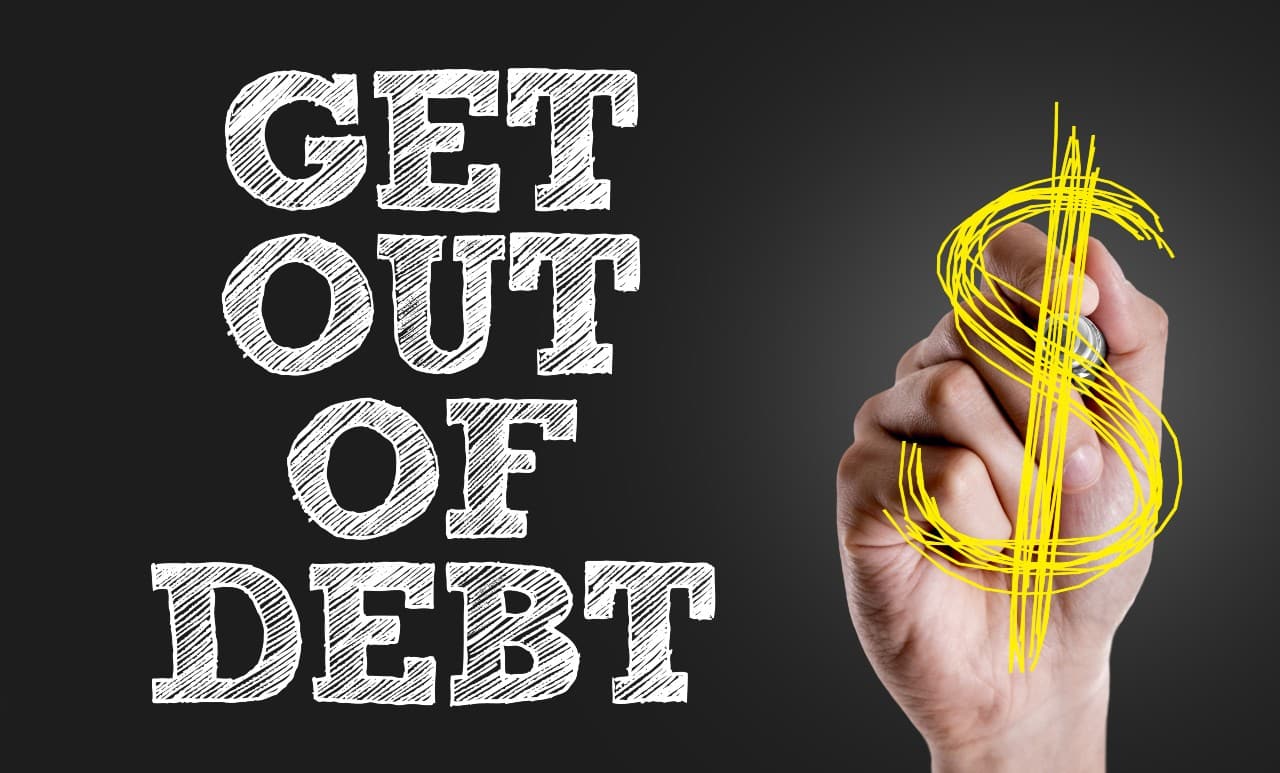Juggling multiple high-interest credit card balances can be a challenge, and it creates stress on your budget that can lead to insolvency. If minimum payments aren’t working and you can’t seem to get ahead of your debt, it may be time to get professional help. One option you should consider is a debt management plan. It’s a debt relief solution that makes it easier to pay off your debt faster.
What is a debt management plan?
A debt management plan – also known as a debt management program or DMP for short – is a professionally assisted repayment plan for credit card debt. You enroll in a DMP through a credit counselling agency, once the agency reviews your financial situation to make sure the program is the best solution for your needs.
Debt management plans consolidate your credit card balances into one simplified repayment schedule. However, unlike debt consolidation loans, you still owe your original creditors. The credit counselling agency simply helps you arrange a repayment schedule that works for your budget. They also negotiate to reduce or eliminate interest charges applied to your balances.
This is what makes these plans so beneficial. By minimizing interest charges, it makes it faster and easier to pay off your debt so you can regain financial stability.
How does a debt management plan work?
Step 1: See if you qualify through free credit counselling
The first step to enrolling in a debt management program is to see if you are eligible. This means contacting a nonprofit consumer credit counselling agency for a free debt and budget evaluation.
- A credit counsellor reviews your debts, credit, and budget to see where you stand with debt.
- Then they explain all of the options available that could help you get out of debt. This could include:
- Consolidation loans
- Debt management plans
- Settlement programs
- Consumer proposals and bankruptcy
If a debt management plan is the best option to use in your situation, you can enroll directly through the credit counselling agency. Before the end of your consultation, the credit counsellor will tell you what your estimated monthly payment will be. You can enroll immediately or take your time to decide.
What makes someone a good candidate for debt management?
These plans tend to be the best solution for people who are focused on repaying everything they owe. They’re beneficial to people who are mainly keeping up with their payments but may be starting to struggle to make ends meet. DMPs offer the most significant benefit when a consumer’s credit card debts are still with the original creditor before they are sold to a third-party collector.
A debt management plan will only work if you have the means to make the monthly payment. The program often reduces your total monthly credit card payments, but you will still need to pay something each month to get out of debt.
DMPs are ideal for people who owe more than $10,000. They are one of the few debt relief options that work for extremely high levels of debt. Canadians have successfully used debt management plans to consolidate upwards of $75,000 and even $100,000 in debt.
What can disqualify you for debt management?
To enroll in a debt management plan, you must have a steady source of income. Otherwise, you won’t be able to make the monthly payments. If you and your counsellor can’t work out a budget that ensures you can afford the monthly payments, you may not be qualified to enroll. On the other end of the spectrum, if you’re budget shows too much excess income you won’t qualify for a debt management plan.
DMP mainly deal with unsecured debt. If your debt is mostly comprised of secured debt a DMP is not the right option for you. Any debt from creditors that have started legal action will also be ineligible.
Step 2: Enrolling in the program
Once you decide you want to enroll, the credit counsellor will request specific information about your debts, including:
- Creditor names
- Account numbers
- Current balances
- Account statuses (current, behind, or charged-off)
They will confirm what monthly payment will work for your budget. Then they call your creditor to begin negotiating. During the negotiation, the agency has three goals:
- Get your creditors to accept lower monthly payments through your debt management plan.
- Reduce or eliminate the APR applied to your balance.
- Stop any extra penalties or fees.
Each creditor must agree to allow the agency to include that debt in your DMP before your plan can officially start. You will receive acceptance letters from each creditor as they agree to the plan terms.
During this enrollment period, you should continue to make minimum payments on your accounts. The credit counselling agency will let you know when all of your creditors have accepted the terms and when your program payments will officially start.
What debts can I include?
Debt management plans provide relief from high-interest credit card debt. This includes general-purpose credit cards, charge cards, gas cards, and store credit cards. Most major creditors and retailers have established relationships with credit counselling agencies. So, they usually allow and include these debts in the program.
However, you may also be able to include other debts that you need to consolidate, as long as the debt is unsecured, and the creditor agrees to accept payments through your plan. This may include:
- In-store credit lines
- Unsecured personal loans
- A personal line of credit (LOC)
- Debt consolidation loans
- Debts in collections
Debt secured with collateral, such as a mortgage, home equity loan, home equity line of credit (HELOC), or an auto loan is not eligible. You also cannot include student loans.
Step 3: Complete your plan to become debt-free
Once your program begins, you will make one payment each month to the credit counselling agency. Then they distribute the payment to your creditors as agreed. The fees are fixed, which makes it easier to manage within your budget. You can also work with your counselling team to find a payment due date that works for when you receive income and need to pay the rest of your bills.
While you are in the program, any credit cards and lines of credit that you include in the program will be frozen. This means you cannot make any new charges on those cards. Your credit report reflects that you’re making payments through a DMP.
You won’t be able to open any credit cards while you’re in the program. You may be able to get secured credit, such as a mortgage or auto loan, while you’re enrolled. However, this depends on your credit score and ability to qualify.
As you’re working your way through the program, the credit counselling agency is there to help you set up a budget, so you won’t struggle to live without relying on your credit cards. They will also provide financial literacy education resources, which will help you learn better financial habits moving forward. That way, once you graduate, you’re better equipped to avoid problems with debt in the future.
What happens if you leave the program?
Enrolling in the program is entirely voluntary, which means you can drop out at any time if your situation changes. For example, if you aren’t able to keep up with the payments and decide you want to declare bankruptcy, try debt settlement, you’re permitted to do so. You may also choose to drop out if your financial situation improves, such as getting a new job or a raise, and you can afford to pay your debts on your own.
If you leave the program, your creditors will likely restore your original interest rates, as well as any previous fees on your account. However, your account reflects any payments you made through the plan.
Debt management plan costs
There are two costs associated with debt management plans:
- Reduced interest charges for the credit cards you enroll
- Fees to the credit counselling agency for the setup and monthly administration of your DMP
Interest rates
In many cases, your creditors will agree to eliminate the APR applied to your debt entirely. However, some creditors may only agree to reduce interest charges, instead of eliminating them. In most circumstances, you can expect your rates to be reduced to between zero and five percent.
All interest charges you pay while you’re enrolled will go to the creditors of your respective accounts.
Fees
Nonprofit credit counselling agencies work to keep fees as low as possible. However, the agency does incur some costs to set up and administer your plan. This means you should expect to pay a one-time setup fee, followed by monthly administration fees.
All fees roll into the monthly payment you pay on your plan, which helps ensure you can afford the program. It’s important to note that not all credit counselling agencies are not-for-profit. For-profit agencies generally charge higher fees for their services.
So, make sure you’re working with a nonprofit agency before you sign up for a debt management plan. That will help you keep costs as low as possible.
Will my credit score be affected?
Enrolling in a debt management plan will have a negative impact on your credit score. Any debt enrolled in a debt management plan will have an R7 rating on your credit report. You’ll see This notation anytime you repay a revolving credit line on an adjusted payment plan.
This notation generally remains on your credit report for two years after you leave the program. R7 notations tend to negatively impact your credit score because it shows you weren’t able to repay a debt on a standard repayment schedule.
The degree to which a DMP will affect your credit score depends on your credit history and how many other negative items you have on your credit report when you enroll. The impact will be more significant if your credit score is high when you join versus a consumer who’s incurred other penalties beforehand.
Specialized debt management plans for…
Couples
If you hold debts jointly with a spouse or family member that you wish to enroll in the plan, you must enter together. The credit counsellor will help you set up a plan that will cover all of the jointly held debts that you wish to include. Both spouses may also be able to include debts that you hold individually. Together, you will have one monthly payment. The counsellor will help you set up a joint budget that will work for your household.
Military families
Some credit counselling agencies may offer discounts for members of the Canadian Armed Forces and Veterans. Agencies may be willing to reduce or waive the plan setup fee, as well as monthly administration fees. If you served in the CAF or are currently serving, check to see if the agency will offer any discounts before you enroll.
Debt management plan pros and cons
Every debt relief option has its benefits and drawbacks. It’s essential to weigh these pros and cons and compare them to other solutions to make sure you’re making the best choice for your finances.
| Pros | Cons |
|---|---|
| You will pay back everything you owe, which can give you a sense of accomplishment. | Your credit cards will be frozen when you enroll, and you can’t open any new credit cards during the program. |
| You can use a DMP for high levels of debt, even upwards of $100,000. | A DMP may take longer and have higher total costs than other solutions, such as debt settlement. |
| The APR applied to your debt will be eliminated in most cases, or at least reduced. | A debt management plan will create a negative notation on your credit report, which may decrease your credit score. |
| Instead of juggling multiple bills, you only need to pay one monthly payment. | Most credit cards will be closed when you graduate from the program. |
| Your total monthly payments will be reduced by up to 30-50 percent, on average. | You may have trouble getting unsecured credit directly after the program and may need to use cash deposits to open secured credit cards to rebuild your credit. |
| You will be out of debt in 36-60 payments, on average (3-5 years) | |
| DMPs cause less credit score damage than other solutions, such as settlement and bankruptcy. |
Comparing a DMP to other solutions
Debt management vs consolidation loans
Both of these solutions consolidate your debts into one monthly payment. They also both typically reduce your monthly payments. However, with a consolidation loan, you take out new financing to pay off your existing debts. With a DMP, you still owe your original creditors; the credit counselling agency acts as a go-between for you and your creditors.
Consolidation loans tend to work better for people who owe less than $20,000 and who have excellent credit scores. If you have more debt or bad credit, a debt management plan tends to be a better option.
Debt management vs settlement
People often get debt management and debt settlement programs confused, but they are very different. A settlement program pays back only a portion of each debt you owe. This leads to greater credit score damage because you don’t pay back everything you borrowed and charged.
On the other hand, settlement programs often provide a faster way to get out of debt. Most programs take 24-48 months, as opposed to 36-60 months with a DMP. The total costs are lower with debt settlement as well.
Even though the fees are much higher – up to 25 percent of each debt amount settled, the total cost is lower because you only pay back a percentage of the principal debt owed. You still make monthly payments on a debt settlement program, but they’re also typically lower than debt management.
Debt management vs consumer proposals
Like debt settlement, consumer proposals pay back only a portion of what you owe. Instead of working with a credit counselling agency, you hire a licensed insolvency trustee. They review your budget to determine how much you can reasonably afford to repay for each debt.
Both solutions still involve making monthly payments to your creditors, and both programs hold you to 60 payments or less. Consumer proposals have higher costs. These proposals cost around $1,500 to file, on average, then you pay a setup fee and additional fees to the trustee.
Consumer proposals have a more significant negative impact on your credit score. They can generate an R7 or R9 penalty on your credit report. R9 is the same penalty you incur when you file for bankruptcy.
Consumer proposals also create a permanent public record online. People can search a database to see you used a consumer proposal, even decades later. Once a debt management plan credit report penalty expires, there will be no record that you needed assistance to get out of debt.
Common questions about debt management plans
Can a debt management plan help with collections?
You may be able to include debt collection accounts in a DMP, as long as the collector agrees to accept payments through the program. However, you lose some of the primary benefits of the program. A debt management program helps consumers reduce or eliminate interest charges, so it’s easier to pay off a debt.
Once a credit card debt passes to a third-party debt collector, they can no longer apply additional interest charges. So, there are no interest charges to minimize with a collection account.
If you only have one or two collection accounts and want to stop the collection calls and pay them off, then you can include them with your other debts. However, if most of your debts are in collections, you may be better off with a different solution, such as a debt settlement program.
How long does a plan take to set up?
The initial credit counselling consultation to see if you would be eligible for the program takes about thirty minutes to an hour. However, your plan will only begin once your creditors agree to accept payments through the program. This can take up to a few months, depending on how many creditors you have and how quickly they agree once they speak to the credit counselling agency.
How long does it last?
A debt management plan can only last up to a maximum of 60 payments. So, at most, you will be out of debt in five years. However, most plans finish in about 36 payments or three years. The amount of time a DMP takes depends on the monthly payments you can comfortably afford with your budget. Higher payments mean you will be able to complete the program faster.
The credit counsellor will help you find the best payment to fit your budget, which will determine the time your plan will take. You will know the monthly payment amount and the number of payments you can expect before you enroll.
Is a debt management plan legally binding?
No. Unlike consumer proposals, a debt management plan is entirely voluntary. Both you and your creditors voluntarily agree to the program that the credit counselling agency helps you arrange. You can cancel at any time if you decide you would prefer to repay your debt in another way.
What happens if I can’t afford debt management plan payments?
Before you enroll, the credit counselling team will help you set up a budget. They’ll also determine the monthly payment you can comfortably afford to make. However, emergencies happen, and your financial situation can change. If you see that you will be unable to make a payment, contact the credit counselling agency administering your DMP. They may be able to help you make arrangements to delay or reduce your amount temporarily to ensure you can stay on the program.
When is the best time to use a debt management program?
Debt management programs provide the most significant benefit when the majority of your debts are still with the original creditors. It can be a great way to turn things around if your debts are starting to fall behind or if you fear that you’ll soon be unable to keep up.
You generally enroll in a debt management program when you owe more than $10,000. It’s also usually the best solution to use when you have bad credit and can’t qualify for do-it-yourself solutions but want to minimize credit damage moving forward.
If you see that you’re having trouble making ends meet, call a credit counselling agency. They’ll be able to help you decide if it’s the right time to enroll.
Who offers debt management plans?
All debt management plans come through credit counselling agencies. Both for-profit and nonprofit agencies provide DMPs. It’s generally advisable to use a non-profit agency because the fees will be lower. Non-profit credit counselling organizations are also more likely to have established relationships with a broader range of creditors.
Will a debt management plan affect my mortgage or my ability to get a mortgage?
If you’re already a homeowner, a debt management plan will not affect your mortgage. A DMP should help make it easier to afford your mortgage payments because it will help balance your budget. It also enables you to avoid bankruptcy, where you could be at risk of losing your home.
Debt management won’t prevent you from getting a mortgage. Enrollment only bars you from opening new revolving credit lines while you’re enrolled. However, being in the program will show up as an R7 notation on each debt included in the program.
These notations will be visible to mortgage lenders. They can also negatively impact your credit score.
A debt management plan won’t prevent you from securing a mortgage. However, lenders may scrutinize your finances more carefully before you are approved. You may also get approved for a lower loan amount and face higher interest rates.
This also applies to car loans.
Getting started
If you think a debt management plan may be the right debt solution for your needs, here is what you should do next:
- First, you should gather up all of the information the credit counsellor will need to complete your free debt evaluation. This includes:
- Your most recent credit card statements so you can provide your account balances, APR, and creditor names.
- A summary of your total monthly income, including wages from paycheques, as well as income from any side businesses or part-time jobs, and things like child support.
- Estimates of your total monthly expenses, including bills and recurring expenses like groceries and gas.
- Second, you should go online to do some research on credit counselling agencies. You want to look for a credit counselling organization that:
- Is a registered non-profit
- Is highly rated by the Better Business Bureau
- Has good reviews on independent third-party review websites
Once you find an agency that meets all those criteria, call them to request a free debt evaluation. By the end of the phone call, you should feel comfortable and confident in the agency’s ability to assist you in getting out of debt. If you don’t have a good feel for the company or still have concerns, you’re under no obligation to enroll in their debt management program. Thank the credit counsellor for their time, hang up and call another agency.
Questions to ask before you enroll
Before you decide to enroll in a debt management plan, you should know the answers to the following questions:
Your credit counsellor should be able to tell you how much you can expect to pay each month once you’re enrolled. Keep in mind that this payment is only an estimate and will not be final until all your creditors agree to the terms of the program. In other words, the expected monthly payment may be subject to change if a creditor requires a high fee to agree to the program.
You should also have a budget that you worked out with the counsellor that ensures you’ll be able to afford this monthly payment and your other bills.
Not only should you know the monthly payments, but you should also know exactly how many payments it will take to become debt-free. The average debt management plan takes roughly 36 payments to complete. A plan can have a maximum term of 60 payments.
The credit counselling team is there to ensure your DMP runs smoothly. If you realize that you may not be able to make a payment on time, contact the agency immediately. They should be able to help you make arrangements to ensure you can maintain your enrollment.
Most credit counselling agencies provide free financial literacy education to help their clients build better financial habits. While you’re in a DMP, you should take advantage of all the resources the agency offers, so you can learn how to budget, save, manage debt, and maintain a high credit score



